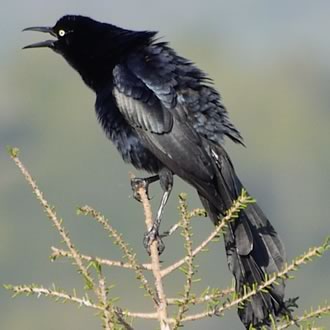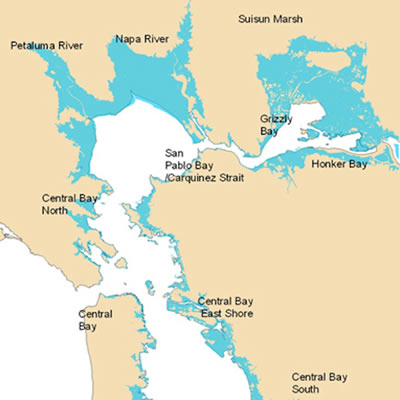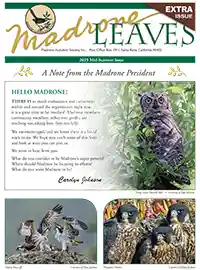Climate Change
Audubon's Birds and Climate Report 2014
Released on September 9th, 2014 by National Audubon. Click here or scroll down for an introduction and link to their site
Climate change is a reality. Concern about climate change patterns is growing. We see drier and warmer winters here in Sonoma County, less rain, drought, and changes in local, regional and global weather patterns. Birds nest in, reside in or migrate to coastal, wetland and upland areas of Sonoma County, based on historical breeding patterns. How will we here in Sonoma County be able to identify, understand and address climate change patterns locally to support migratory and resident birds and wildlife in their efforts to sustain?
A presenter at a Madrone Audubon 2014 monthly membership meeting said any time we discuss birds and wildlife today, we must also now discuss climate change. We agree.
Please visit our Climate Change section often, review entries, and share with us relevant information for our web site by emailing us via the contact form.
A citizen science way to monitor possible changes in normal migratory, resident and nesting bird behavior is to observe for change in arrival and departure time of local birds; changes may be noted in time of singing, nest-building, or of acquiring breeding plumage.
Local and Regional Issues | Climate Change Patterns to Observe | Articles, Studies, Reports | Links | More Background on Climate Change
2014
A study on Black Oystercatchers on the California Coast has been published in Marine Ornithology. Several Madrone Audubon members participated in the survey. A link to the article is below, under the Articles, Studies, Reports section.
2013
- Influx of Blue-footed Boobies along the CA coast as far north as Bodega Bay.
- Die-off of seabirds and marine mammals that normally feed on sardines, when their numbers crashed.
- Influx of Great-tailed Grackles into Sonoma County – breeding observed at Ellis Creek.

Climate Change Patterns to Observe
- Sea level rise.
- Habitat loss, especially for birds nesting near the high tide line such as Black Oystercatchers.
- Ocean acidification.
- Inland and wetland drying patterns, drought, loss of water and nutrition to support migrating birds.
- Mismatch of timing for bird nesting and their food items.
- Heat stress as occurred at Alcatraz and the Farallones in recent years, causing nesting failures of Brandt’s Cormorants.
- Increase in invasive species.

Climate change would hurt coastal birds… (March 12, 2010, Press Democrat)
http://www.pressdemocrat.com/article/20100312/articles/100319725
To a long list of predators and threats, the western snowy plover, a sparrow-sized bird that nests in sandy beaches on the Sonoma coast, has a...
Sea level rise – USGS report with implications for Bay area wetlands (May 28, 2013)
http://www.usgs.gov/blogs/features/usgs_top_story/san-francisco-bay-could-lose-marshes-to-sea-level-rise-by-2100-2/
American Black Oystercatcher, known as BLOYs in birding lingo, is a Focal Species identified for priority conservation action by US Fish & Wildlife Service. Audubon-California selected BLOY as an Indicator Species for global climate change because of its linkage to the tide. This shorebird nests and feeds closest to the mean high-tide line, so is vulnerable to sea level rise. A number of West Coast/State/and local Sonoma County studies are being conducted on BLOYs to determine current populations and nesting success, and to locate and follow up on nest siting. A population assessment has been published in Marine Ornithology.
California Audubon - http://ca.audubon.org/policy-action-climate-change
California Avian Data Center (future maps of SF bay) - http://data.prbo.org/cadc2/
National Audubon - http://climate.audubon.org/
American Bird Conservancy - https://www.abcbirds.org/abcprograms/policy/globalwarming/global_warming_factsheet.pdf
More Background on Climate Change Patterns
Coastal Climate Change: Audubon California reports impacts to the California Current by change in timing and intensity of summer upwelling events. (ca.audubon.org/seabirds). Other expected effects include ocean acidification, presenting difficulty for most species of shellfish to thrive, and increased dinoflagellate blooms, suspected to be taking place now. Overall, seabirds will be affected in different ways. Some species may do better, some worse. Predictions are difficult and at this time are speculations - which is why it is critical to increase the amount of surveillance of trends in seabird populations over the long term.
Ocean Acidity: An Associated Press article from the Monterey Bay Aquarium explains acidity issues: "We're having a change in water chemistry, so 20 years from now the system we're looking at could be affected dramatically but we're not really sure how. So we see a train wreck coming," said Andrew DeVogelaere, the sanctuary's research director, while out kayaking in Fall 2013 with a reporter in the cold waters. Oceans absorb about 25 percent of the world's greenhouse gases pumped into the atmosphere from human activities each year, helping to take off some warming pressure. But carbon dissolving in oceans also forms carbonic acid, raising waters' acidity that damages all manner of hard-shelled creatures, and setting off a chain reaction that threatens the food chain supporting marine life, including the lumbering sea mammals along the 276-mile coast of the California sanctuary and the rest of the U.S. West Coast.
Mismatch of Timing: The Sooty Shearwater nests in New Zealand but comes off our coast to feed. If the timing is disjointed loss of nests and chicks could result. Recent years have seen major die-offs or“mortality events” in Brown Pelicans and in California Sea Lions. It appears that insufficient food was found near their feeding areas. We do not know the cause.
National Audubon's Birds and Climate Report
This report is a comprehensive, first-of-its kind study that predicts how climate change could affect the ranges of 588 North American birds. Below is an introduction from Audubon's new website:
Audubon scientists used three decades of citizen-scientist observations from the Audubon Christmas Bird Count and the North American Breeding Bird Survey to define the climatic suitability for each bird species: the range of temperatures, precipitation, and seasonal changes each species needs to survive. Then, using internationally recognized greenhouse gas emissions scenarios, they mapped where each bird's ideal climatic range may be found in the future as the climate changes. These maps serve as a guide to how each bird's current range could expand, contract, or shift across three future time periods (2020, 2050, and 2080).
What are the primary findings?
Of the 588 North American bird species Audubon studied, more than half are likely to be in trouble. Our models indicate that 314 species will lose more than 50 percent of their current climatic range by 2080.
Of the 314 species at risk from global warming, 126 of them are classified as climate endangered. These birds are projected to lose more than 50 percent of their current range by 2050. The other 188 species are classified as climate threatened and expected to lose more than 50 percent of their current range by 2080 if global warming continues at its current pace.
For a list of 107 Sonoma County species at risk, compiled from National Audubon's study data, click here
For more in-depth coverage, including range maps for each species, a short video, and the invitation to take a pledge to help build a brighter future for birds, go to Audubon's new website, climate.audubon.org
Find us on Facebook 
It's Nesting Season: trim trees in the Fall!.
Amazon Smile: donate to Madrone when you shop
Birding Quiz - test your skills.
Leaves Newsletter


Carved Bird Pins
In the 1970s, member Tom Olds hand-carved bird pins and sold them to raise money for Madrone Audubon. More
